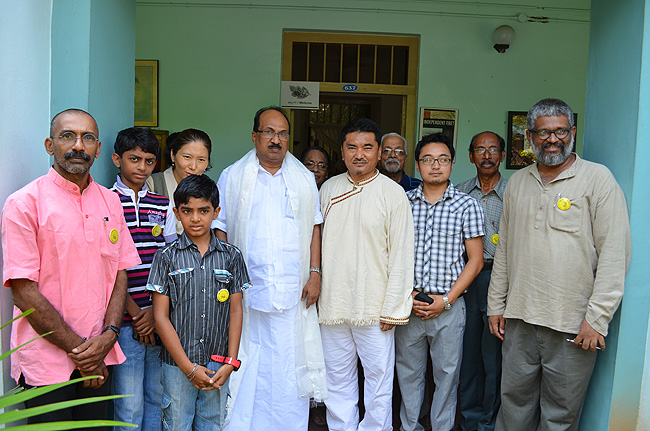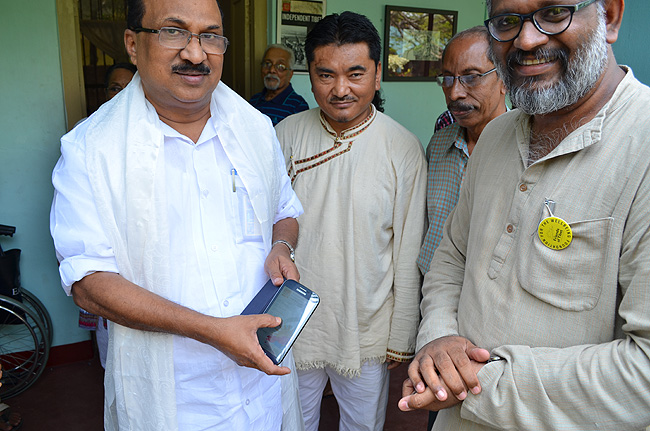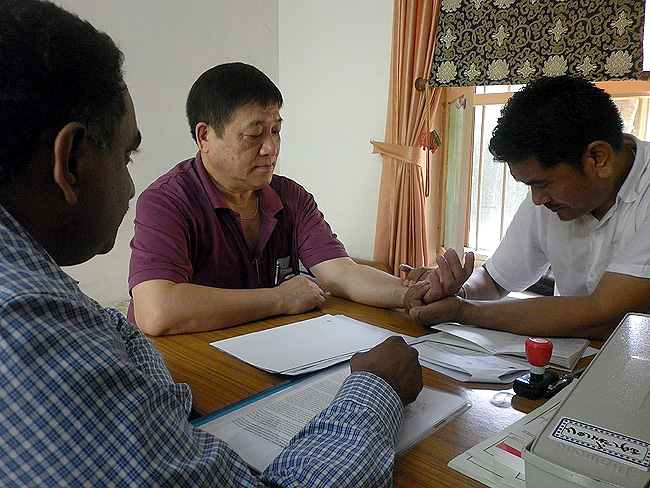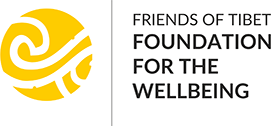The Wellbeing Programme is a philanthropic initiative by Friends of Tibet, a non-profit service organisation founded in Mumbai in 1999 to support the cause of Tibet and to create awareness about the issue of Tibet amongst people all over the world. This initiative is researched, designed and implemented by Friends of Tibet members, volunteers and the beneficiaries of the Wellbeing Programme. Friends of Tibet Foundation for the Wellbeing aims at the restoration, propagation and promotion of the endangered traditions and practices of Tibet.
HOME
April 6, 2013: Union Minister for Consumer Affairs, Food and Public Distribution of Government of India, Prof KV Thomas with Friends of Tibet Wellbeing Volunteers and doctors and staffs of Men-Tsee-Khang, the Tibetan Medical and Astrological Institute of His Holiness the Dalai Lama after inaugurating the Wellbeing Mobile Application (http://goo.gl/dVb75) developed by ThoughtShastra Solutions, Mumbai. (Left to Right) Yeldtho Mathew, Kelvin Yeldtho, Elvin Yeldtho, Dr Tenzin Lheundup, Prof KV Thomas, Dr Dorjee Rapten Neshar, Thrivikraman, Nirmala Thrivikraman, Dr Thinley Namgyal, Suresh Babu and Sethu Das. (Photo: Venu B Nair)
Modern Health Drinks: The Tibetan Connection
Kochi, Kerala, India: The 28th edition of the Wellbeing Tibetan Health Camp was jointly organised by Friends of Tibet and Men-Tsee-Khang, the Tibetan Medical and Astrological Institute of His Holiness the Dalai Lama from April 3-6 at Ashirbhavan in Kochi, Kerala, India. A number of needy attended and found relief for their ailments. It is a happy site as one surveys the happy faces of many who had walked in sadly a few camps. The sincere efforts shown by the Wellbeing Volunteers, the wonderful care from the doctors and the health-giving atmosphere of the campsite also provided great service to bring back the smile in the faces of these patients. Anyway Tibetan medicine has got some magic that energises even the gloomiest patients.
Energy and its flow is a key feature of Tibetan medication. The vital energy — "ojus" is the representation of each manís soul. Itís an unending flow — flowing with in one's body and even outside it. This energy transfer can be felt by the doctors when they hold our hands tightly and press it on the pressure points. Pulse diagnosis requires rigorous training and constant practice. However the same is not possible for ordinary mortals like us. For us energy is something that makes us move. To say it in the simplest terms when there is a surge of energy we are happy when it is low we are sad. All of us are bothered by energy. A mother in a family is most bothered by the energy needs of the family. She is the head of the kitchen and it is the powerhouse which supplies us with energy for our day to day activities. In the case of children we are more anxious about their energy requirements. The easiest way is to supplement their needs with some energy drink. Hundreds of brands are available in the market at varying price range. But which is the best one? We have hundreds of options but we are still in the darkness in choosing the best one for our loved ones.
Here too we find the influence of Tibet. If we read the contents of the so-called health drinks some write it as malt some others as malted barley. Yes truly its barley + sugar + water mixed well. Now you might be thinking what that has got to do with Tibet? Tibetans were one of the first in the world to understand the goodness of barley. Tibetans use the same malt mixture for their breakfast. Tsampa or roasted barley powder mixed with molasses or salt, yak cheese and yak butter and occasionally some cow ghee is mixed together and eaten with traditional Tibetan tea or hot water. Wikipedia, the online encyclopedia cites it as follows:
April 6, 2013: April 6, 2013: Union Minister for Consumer Affairs, Food and Public Distribution of Government of India, Prof KV Thomas launches the Wellbeing Mobile Application (http://goo.gl/dVb75) developed by ThoughtShastra Solutions, Mumbai. Dr Dorjee Rapten Neshar, Suresh Babu and Sethu Das next to him. (Photo: Yeldtho Mathew)
"You leave a little buttered tea in the bottom of your bowl and put a big dollop of tsampa on top of it. You stir gently with the forefinger, then knead with the hand, meanwhile twisting your bowl round and round until you finish up with a large dumpling-like object which you proceed to ingest, washing it down with more tea. The whole operation demands a high degree of manual dexterity, and you need a certain amount of practical experience before you can judge correctly how much tsampa goes with how much tea. Until you get these proportions right the end product is apt to turn into either a lump of desiccated dough or else a semi-liquid paste which sticks to your fingers. Sometimes you lace this preparation with a form of powdered milk, made from curds which have been dried in the sun." (taken from Migot, Andrť (1955). Tibetan Marches, Translated and with an introduction by Peter Fleming, p. 103. EP Dutton & Company, Inc., New York.)
It is also culturally and politically significant. Besides being the substantial part of the Tibetan diet, its prominence also derives from the tradition of throwing pinches of tsampa in the air during many Buddhist rituals. It is believed that this belief was their even before the advent of Buddhism. It was originally used as an offering to the pagan gods for protection which was later incorporated into Buddhism to celebrate such occasions of happiness like marriages and birthdays and in New Year celebrations and at funerals. Tsampa is used in a number of other ways. Mashes of tsampa and cumin are sometimes applied as house hold medicine for sore spots. It is known among Tibetan sportsmen for its ability to provide rapid energy boosts; the roasting of the flour breaks it down to an easily digestible state, allowing the calories therein to be quickly incorporated by the body. Reflecting its foundational role in Tibetan culture, "Tsampa" is also the name of a Tibetan typeface. The phrase "tsampa-eater" was used to promote a unified Tibetan identity. Whereas Tibetans speak mutually unintelligible languages, worship in different sects, and live in different regions, all Tibetans were thought to eat tsampa. In 1957, the India-based Tibet Mirror addressed a letter to "all tsampa-eaters", encouraging them to participate in what would become the 1959 Tibetan Rebellion. Recently, with the rise of the Tibetan diaspora, less emphasis has been placed on tsampa and more emphasis on Tibetan Buddhism in constructing a unified Tibetan identity.
Hence next time when you buy some health drink not just read the contents or just gobble it up without knowing the contents; think of the Tibetans, from whom this original recipe was stolen. Also think about the land taken away from them. May be one day we can bring back the smile on their faces as they have done for us on each camp and each occasion when we meet them...!
CL Denzongpa (DGIT: Investigations) consults Dr Dorjee Rapten Neshar during the 27th Wellbeing Tibetan Camp at Kochi, Kerala organised by Friends of Tibet and Men-Tsee-Khang. Dr Madhavachandran (R&D, Nagarjuna Ayurveda) next to them. (Photo: Friends of Tibet)
Friends of Tibet Foundation for the Wellbeing, PO Box 16674, Bombay 400050, India.

Report by: Appu Jacob John, Researcher and Friends of Tibet Campaigner based in Kerala, South India. He can be reached at appu.john@friendsoftibet.org


![]()
Email: wellbeing@friendsoftibet.org Web: www.friendsoftibet.org/wellbeing/
